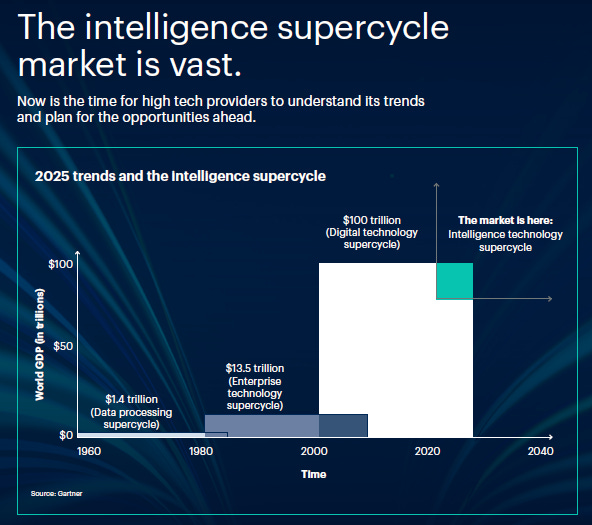Agentic AI and the Intelligence Supercycle: The $100 Trillion Shift No One Is Ready For
AI is no longer just software. It’s becoming the architect of decisions, industries, and value itself. Prepare accordingly.
Technology evolves in waves, but what we’re entering now isn’t just a wave — it’s a supercycle. Gartner calls it the “intelligence supercycle”, a period where AI stops being a tool and starts becoming an autonomous actor, reshaping how software, businesses, and even entire industries operate.
Agentic AI is the tipping point. Unlike today’s Generative AI, which largely generates content and insights, agentic AI executes. It doesn’t just tell you what to do, it does it. By 2028, a third of enterprise software will include agentic AI, a leap from virtually zero today. This isn’t incremental progress; it’s a complete rewrite of the software’s purpose. AI agents will act as decision-makers, collaborators, and even “digital employees,” automating not just tasks, but judgment calls.
Decisions are shifting from humans to algorithms. Within three years, 15% of day-to-day work decisions — hiring, pricing, operational tweaks — will be made autonomously. This challenges not only workflows but corporate governance. If your competitor’s AI can make 1,000 smart decisions in the time it takes your team to debate one, you’re already behind.
The $100 trillion opportunity. Gartner frames this moment as the next great supercycle, dwarfing previous ones like enterprise computing and data processing. We’re transitioning into a digital economy where the intelligence layer — synthetic data, large language models, domain-specific AI — becomes the primary value driver. Companies that understand this shift will stop seeing AI as a product and start seeing it as infrastructure.
Download the entire infographic here:
Cloud walls are coming down. “Cloud without borders” is another hallmark of this cycle. The old model of vendor lock-in is dying because AI’s value isn’t in storage or compute anymore, it’s in the intelligence layer that sits above it. Cross-cloud integration is the new competitive moat.
Synthetic data is exploding. Real-world data was once the bottleneck for AI. Not anymore. Synthetic data is removing constraints, making AI training faster, cheaper, and infinitely more adaptable. In practice, this means businesses can build hyper-specialised domain models without needing massive proprietary datasets.
Speed beats risk. The report warns that “speed to impact > cost of risk.” In plain terms: moving fast with AI is now less risky than standing still. Those who wait for the “perfect” model or governance framework will lose to those who experiment and iterate.
The intelligence supercycle isn’t just about AI’s capability; it’s about AI agency. The real winners won’t be those who build the most powerful AI, but those who let AI build for them.



